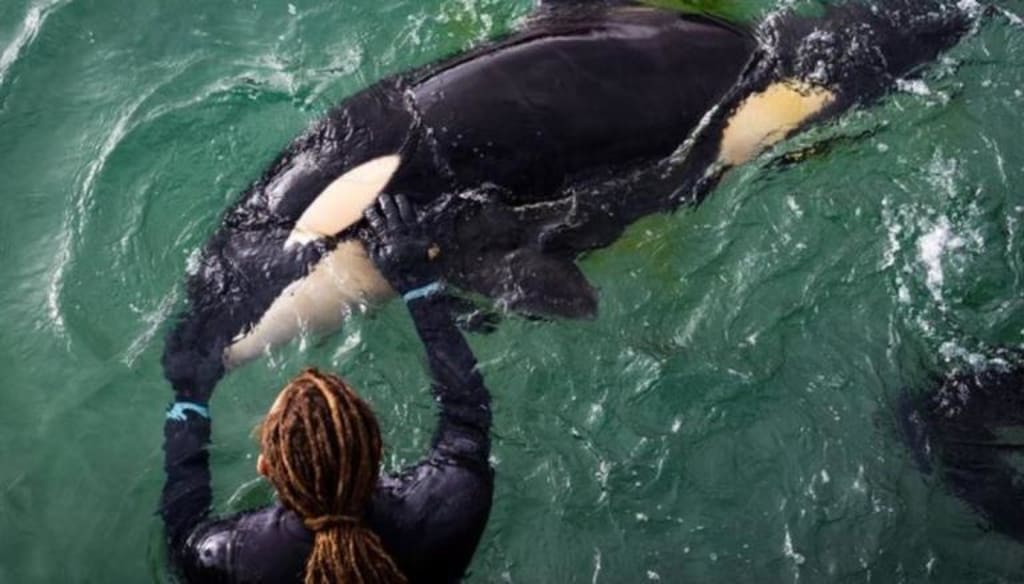A Tale of Two Rescues: How Experience and Resources Derived From Marine Mammal Facilities Drives Success in Whale Stranding Operations.
The recent rescue of a killer whale calf off the coast of New Zealand is once again raising eyebrows at the questionable decisions of anti-zoo advocate Ingrid Visser.

On July 11th, two self-titled “conservation” groups took charge of a beached killer whale calf off the coast of New Zealand under the authority of the New Zealand Department of Conservation. One group is Dr. Ingrid Visser fronted Whale-Rescue.org, and the other is Project Jonah, a group that previously had ties to the radical Sea Shepherd Organization in the late 2000s and early 2010s. For those who are unaware, Dr. Visser has led campaigns that target accredited marine mammal facilities that house cetaceans. This includes her efforts with the Free Morgan Foundation, which is dedicated to the release of a rescued orca under human care with documented hearing loss and an inability to hunt for herself. Sea Shepherd spearheads Operation 404, which has the following tagline on its skull and crossbones logo: ‘If You Support Captivity Sea Shepherd is Coming for You’.
In addition, both Loro Parque and SeaWorld offered help with caring for the calf, but were both declined by Visser and the other personnel involved. The groups carrying out this rescue refused to draw upon the experience and knowledge of managed care facilities, which sets up an interesting contrast and allows us to address an important question: do animal rights activists fare better or worse than rescue groups with contacts and connections with marine mammal facilities?
According to reports, they found the calf stranded in Plimmerton, New Zealand during the night, intending to release him back to his wild pod. However, the two attempts at releasing the calf failed. Dr. Visser later advised bystanders involved in the rescue attempt to take him out of the water and transport him to a boat ramp. The volunteers held him in the water for over an hour waiting for his family pod to arrive, but that too failed. The calf, named “Toa”, moved to a shallow makeshift sea pen for rehabilitation where he responded to the limited nutritional supplements that the Whale-Rescue staff had on hand. When the weather took a turn for the worse, Toa moved to a small freshwater pool to continue his rehabilitation. One volunteer involved with the efforts claimed it had saltwater pumped into it but omitted it using a filtration system to keep it clean during his time there. Once conditions cleared, they returned him to the pen. Despite the efforts, Toa died after he failed to make a full recovery.
During the 13 days Toa was under Dr. Visser’s care, New Zealand’s Department of Conservation made it a top priority. This meant that groups from all sides of the zoo debate would’ve required the two to work together, hoping Toa would make a full recovery so that they could successfully reunite him with his wild pod. We applaud the efforts of both locals and pilots for their endless efforts to search for his pod. We also thank Loro Parque and SeaWorld for offering to use their expertise in assisting in Toa’s recovery.
Our concerns come from the practices Dr. Visser and her colleagues have engaged in, and the failure of this operation because of poor decision making. Especially because there is precedence that gives reason for concern and history has once again repeated itself. Dr. Visser has published a series of papers on killer whale behavior and they have well regarded some (Visser, 1998). But experience in this realm doesn’t always translate particularly well to husbandry and captive animal welfare (even if the animal is under temporary human care). Frequently, she has tried to intervene in the rescue of killer whale calves, with her efforts ending with the calf dying. Now high fatality rates are part of the business of marine mammal rescue. Her first known effort to rescue a calf was in the late nineties during the filming of one of her first documentaries. In this situation, Dr. Visser attempted to rescue a malnourished calf by feeding it fish, but the problem was the calf was still at an age where they would still nurse from their mother, who was nowhere to be found. After making several “attempts” to feed the calf, Dr. Visser abandoned the animal, dooming it to its death. For a while, this footage was available for viewing on YouTube, but they have taken it down.
Twenty years later, in 2016, Visser led another failed effort to rescue an orca calf named “Bob” by taking him into a small swimming pool with no filtration system. What made the case very disturbing was when she was allowing both her staff and the public to give him unnecessary hands-on contact. These interactions would range from belly rubs to allowing kids and their parents to pet him during treatment. Another upsetting sight to see during that time was the lack of face masks and gloves that are required to rehabilitate cetaceans. He died in Visser’s care two days later.
Now, five years after Bob’s death, Dr. Visser is once again being criticized for her handling in the failed rescue of another orca calf. While both volunteers and staff were wearing face masks and gloves this time around, there were still reminders of Bob’s rehabilitation that caused concern for Toa’s well-being. For example, the two teenagers who first found Toa were both photographed and filmed interacting and swimming with him as if they were the titular whale from the Free Willy movies. This is an irresponsible move considering Toa was sick and receiving treatment because not only would put his own health at risk but also his well-being had he recovered to the point of release. It’s like allowing toddlers to play with their sick grandparent in an ICU ward. While volunteers still insist the small freshwater pool Toa stayed in during the second half of his rehabilitation pumped salt water, there was no mention of this pool having any filtration. Critics who monitored the outcome of the rescue argued that the pool looked filthy and it was causing his skin to appear like he had some infection going on. Accredited marine mammal rescue facilities, like many zoos and aquariums that house marine mammals, use filtration systems to keep both medical pools and animal habitats clean from bacteria and viruses that would otherwise harm the animal.
After Toa died, they returned his remains to a Maori tribe to be buried not too far away from the original stranding site. Dr. Visser claimed he died after inhaling water shortly after they returned him to his pen. Yet, they conducted no necropsy to determine how he died as soon as they returned him to his saltwater pen. Visser’s supporters claim she could not perform one out of respect to Maori culture, but there are reports of researchers in New Zealand conducting necropsies on cetaceans to determine how they died. Once completed, biologists gave the animals’ remains to the tribes for burial. So, calling for Toa’s necropsy to determine how he died would disrespect neither the Maori tribe nor their culture.
Because New Zealand has banned the keeping of cetaceans in human care since the late 2000s, there are currently no facilities in the country that either house, or rehabilitate sick, injured, or orphaned cetaceans. Because of this ban, many cetaceans that are sick, or injured get immediately euthanized on site rather than being sent to a facility that has both the set-up and experienced staff to provide their expertise in treating them. We believe that the New Zealand government should alter its ban to enable the construction of facilities that can provide rehabilitative care for stranded cetaceans and offer long-term care to animals that get declared “non-releasable”. However, we don’t recommend using activists like Dr. Visser, nor any individuals who lack expertise in marine mammal husbandry and care to take part in the rehabilitation phase, which was one of the main issues in the failed rehabilitation efforts of both Bob and Toa.
We can only hope that the deaths of both Bob and Toa can serve as reminders of why rescue groups need to throw their political views on the keeping of marine mammals in human care aside and work with zoological facilities with actual cetacean husbandry experience. They need to respect modern marine zoological facilities for the sake of the animals they claim they want to help the next time a stranding occurs.
References
Visser, I. (1998). Prolific body scars and collapsing dorsal fins on killer whales (Orcinus orca) in New Zealand waters. Aquatic Mammals, 24, 71-82.
About the Creator
Jenna Deedy
Zoo and Aquarium Professional, Educator, Cosplayer, Writer and B.A. in Psychology whose got a lot to share when it comes to animals, zoos, aquariums, conservation, and more.
Instagram: @jennacostadeedy






Comments
There are no comments for this story
Be the first to respond and start the conversation.